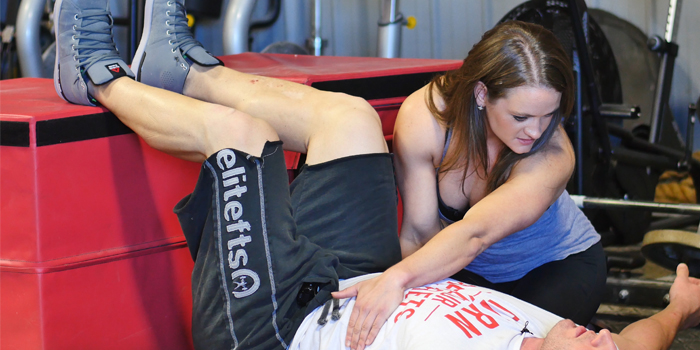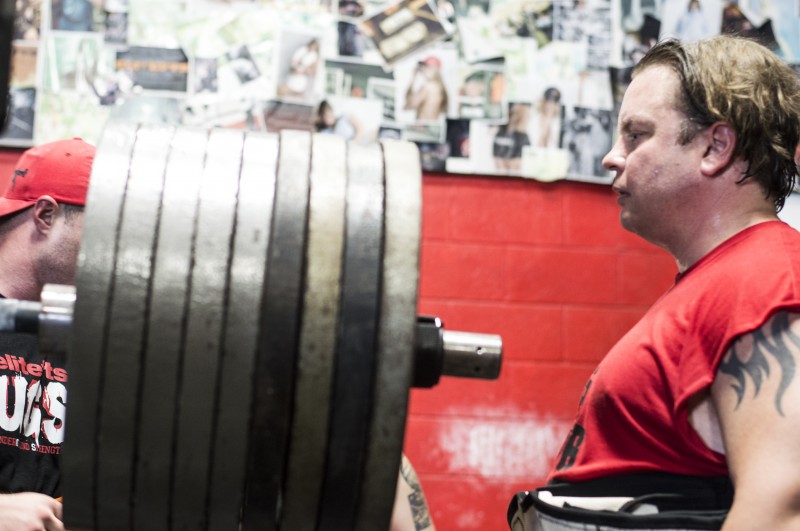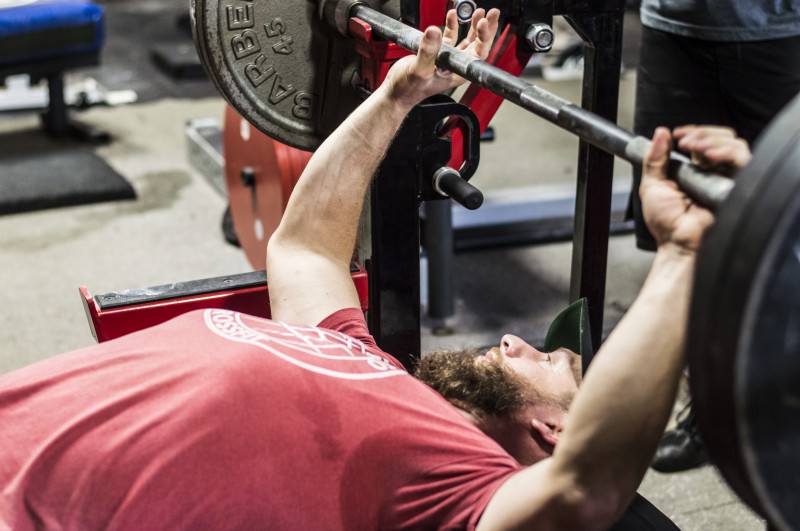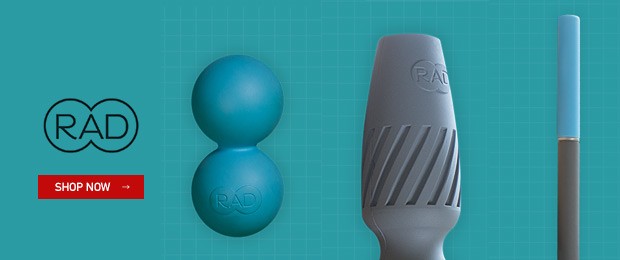
Ever gotten to that point where you can almost feel your pain on command, like you have an awareness of it that lets you turn it on just by thinking about it? Should you train through it? Should you take time off?
Do you really have that many options if all it takes is thinking about your pain to start feeling it? Most of us have run into that period of time where we’ve worked around one, maybe two, or even multiple injuries, and tried to train through. That road inevitably seems to end in one of two places:
1. Compensated strength: incredibly dysfunctional strength and development of compensatory patterns, further increasing risk for injury.
2. Accumulated injury: running out of places to compensate. This is the roadblock that more often than not leads to the situation described above. You’ve run out of places for your body to “cheat” your way through an injury.
RECENT: Rebuild the Squat from the Bottom Up: Your Ankles May Be Shutting Off Your Glutes
Once that cycle starts, and inevitably it will at some point, there’s a third variable dealing largely with the nervous system and the sensitivity to pain that, the more and more I talk to iron sport athletes I realize, may be more of a hindrance than the other two. It also takes a little more time and unpeeling to work through.
At some point, you’ve probably trained with someone who has recently injured themselves squatting or deadlifting, usually either a higher rep set or something near a max that lead to form breakdown and a messy lift.
Factor 1: Occurrence of tissue damage. Over the next few weeks, they may slowly improve or take some time off, or most frequently, they go right back to the movement they injured themselves in with hesitation, altered pattern, and anticipation of pain, even at submaximal weight.
Factor 2: Neuro-psychological anticipation/adaptation. They may continue, week after week, to struggle at a certain weight or threshold due to pain or feeling “off” under the bar in some way. You may see the weight threshold gradually decrease.
Factor 3: Patterned pain. This pain may eventually progress to a degree of fear with decreasing capability and threshold for participation.
At this point, it’s almost like someone can anticipate or feel their pain unracking an empty bar. We too often assume it’s a result of further tissue damage, exacerbated injury, or poor mechanics if the bar is actually loaded. Most times I have a hard time believing that someone squatting mid-500s who injured his back or glute and hasn’t touched weight above 225 in a few weeks is now hesitant with 135 because he’s not receiving proper sleep and nutrition. So what’s the deal, and what can this person do to train in the meantime?
Here’s my perspective. You need to address this multifaceted problem from all angles. There are three specific points to make about this.
1. He may have tissue damage somewhere, which can lead to altered patterning, inhibition of stabilizers, and inflammation. Essentially you’re looking at where the “damage” is coming from, and it’s both mechanical (disruption of tissue) and chemical. It’s always helpful to consult with a healthcare professional regarding what may be happening in the tissue, but regardless, you inherently know the tissue needs to heal. The injured tissue itself may require different stimulus for healing, depending on whether it’s tendon, cartilage, the joint, joint capsule, bone, nerve related, etc. There are a lot of different pain generators, and they have a different optimal stimulus for healing.
2. Address the soft tissue that needs work, through exercise. Rest is good; loading is good. I think this is where there’s a lot of confusion. There’s a diagram out there, the Holten diagram, that’s a little old school science (or incredibly outdated depending on how honest the person you’re talking to is) with regards to strength gains, hypertrophy requirements, and muscular endurance. It’s foundational, simple, and honestly, I believe it to be inaccurate for the competitive powerlifter accustomed to lifting belts, sleeves, or other equipment. But it’s a good example to illustrate that we know certain rep ranges and percentages target specific adaptations. We inherently believe that there’s some sort of “cutoff” that things are more or less helpful. Example: “Lifting anything below 50% isn’t going to drive any strength change.” Is there a time for lifting below the level of the diagram?
Please appreciate the following: Everything you are doing in the gym is meant to incur some change in tissue or histological (cells, structure, makeup) physiology. You’re training to get “stronger” but that incorporates a lot of mechanisms on a cellular level. You are causing your tissue and nervous system to adapt. So when you’re healthy and you want to adhere to Prilepin’s principles, or the Holten diagram, or whatever works for you, that's excellent. But when returning from injury, is the guy mentioned in the above example going to get anything out of squatting 135?
From a histological standpoint, on a tissue level, yes. He will. Let’s say there was a tendinous or cartilaginous breakdown. This means that the tissue that composes that (collagen) needs to be re-worked to heal. In order to re-lay that tissue, some stimulus is needed. Collagen makes up a good chunk of your tendons and ligaments, the good stuff we need for stability. Your tissue “healing” process really is, on a very simple scale, letting the collagen gods run the show. Collagen itself is formed by a process that eventually leads to the aggregation of a precursor called procollagen and then tropocollagen; it helps form some of the lattice that collagen builds upon.
Cells that produce the precursor to collagen, fibroblasts, will benefit from a little egging on, asking them to come to work. Once the fibroblasts get to work, collagen production (again, your healing) increases and becomes stronger when there’s some tension applied to it in its line of pull. There’s some evidence that when fibroblasts are exposed to tension in their line of pull they actually multiply faster, along the line of stress applied, to lay down fibers in that direction. Read that again: when done appropriately, proper work can encourage better healing than “rest” and staying off of an injury completely.
On a joint level, movement in the joint produces a substance called GAG. GAG, generally speaking, pulls water into a joint and lubricates movement. You’re permitting the roll and glide movements that joint surfaces need to move well, prohibiting further immobility of the joint capsule, and using joints throughout an athletically-specific range.
WATCH: Physical Therapy — Anterior Pelvic Tilt Fix with Casey Williams and Dani Overcash
On a movement pattern level, when injury to tissue occurs, one of the most important things that I see when working with lifters as opposed to general population is the role of stabilizer inhibition. You could classify our musculature as either tonic or phasic. Tonic muscles could be considered the postural stabilizers — the ones that will need to make small adjustments consistently to keep you stable in the rest of life and especially under load. Your phasic muscles are the ones working to actually accomplish the task. When injury occurs and that person feels “off" even just unracking the bar, one potential culprit of that feeling is the inhibition of the tonic musculature.
The best news about all this is that in the initial phases of injury, all three of these components can improve with loads as little as 40%. Think low weight, high repetition.
But there’s a bigger issue: the anticipated pain and pain science component of it. I’ve yet to take the formal classes on this pain science, but from what I’ve seen in other lifters and experienced myself, it can play a bigger role than the actual tissue healing if your injury has gone on long enough.
3. Encourage a positive relationship with the movement. Think about it this way: You walk into a crowded room with dozens of people. Have you ever noticed that you can kind of pick out or hear the voices of the people you recognize without really trying? You become a little more attuned to hearing from those people. Our body is a little bit similar; we become accustomed to “hearing” feedback from a certain region of our body. We have tons of different types of receptors in our tissue and in our joints, but very few of them actually signal pain in the sense that we feel. Instead, they signal things like stretching, temperature changes, chemical changes, among others, which all get sent to the brain via tracts in the spinal cord. What ends up happening over time (article to come on chronic pain once I understand it a little better) is that your brain interprets all this “input” as a danger and pain becomes your “output.” Your body’s input to the brain is not pain. Pain is the brain’s interpretation and the output. The best way to modulate this, keeping things simple, is to prohibit that painful “output” from being produced. That means graded exposure to less threatening “input.”
I think the coolest thing about all this, honestly, is that it all really does fit together and flow together well and efficiently. It’s great news for us because it means that a multifaceted problem can be addressed with simple solutions and ideas, namely that it's okay, and a good thing at the appropriate time, to keep the load far lighter than you think you need to in order to elicit change that you need.
By doing this, three things will happen:
- You'll address the tissue healing, stimulating localized as well as global blood flow and stimulus to tissue for structural support.
- You'll prime the tonic musculature, your stabilizers, to turn back “on” from whatever previous inhibition may be there from the initial injury, allowing you to rebuild.
- You'll continue to prime your nervous system to decrease the neurogenic pain response.
We make things more complicated than they need to be. As much as the body is incredibly fascinating and as confusing as it can be when we start talking about pathways to hear talk about "neurogenic this and that" that has sprouted up the last few years, it's great news that it can be stated in simple rules. Let it lend a little clarity to your situation, and when your training partners are bashing their heads in a wall wondering why they aren’t getting better, remember that pain can be a multifaceted issue. Even a few weeks spent encouraging small changes in the body will make a very quick difference.












